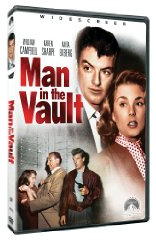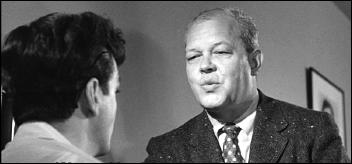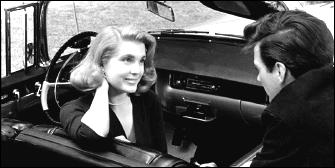Fri 25 Sep 2009

MAN IN THE VAULT. RKO Radio Pictures, 1956. William Campbell, Karen Sharpe, Anita Ekberg, Berry Kroger, Paul Fix, James Seay, Mike Mazurki, Robert Keys, Nancy Duke, Gonzalez Gonzalez, Vivianne Lloyd. Screenplay by Burt Kennedy, based on the novel The Lock and the Key by Frank Gruber. Director: Andrew V. McLaglen.
I’m willing to bet that if you recognize more than two or three of the actors and actresses in this 1950s style crime movie, you’re somebody who looks up somebody on IMBD at least once a day. Casual movie viewers will know only one, and she’s barely in the movie, so if that’s why you might ever pick out this movie to see on DVD, say, you’re going to be out of luck.
The star is William Campbell, and I’ll see if I can’t find a good photo of him. He plays a apprentice locksmith named Tony Dancer in the movie, and he’s hired by a gangster to help pull off a job for him. But getting back to Campbell, I learned a new word today:
Quiff: “Popularized mostly by 50s rockabillys, a quiff is basically a forelock that is longer than the rest of one’s hair on top, and is usually combed upwards (and back), or to the side, or made to hang over the forehead. Depending on the wearers hair type a spot of gel or grease may be in order. Very stylish & manly. If done properly.”

Campbell also looks something like Tony Curtis, and he’s had something like 80 appearances in movies and TV, the last one in 1996, and I don’t believe I’ve ever noticed him in any one of them. Whether that’s my fault or the movies he’s been in, you’d have to go to IMDB and look him up.
The movie’s in black and white, and I’ve never seen it before. All of these years I thought this was one of those grand caper movies, in which a gang of crooks works out a precisely laid out plan to rob a bank. Not so. All Tony Dancer has to do is get inside the room where the safety deposit boxes are, make a key to get into one of the boxes, return and remove the contents.

A little sweat on the brow, hoping the bank teller at the door doesn’t turn around, and there’s nothing to it. Problem is, Tony Dancer isn’t really crooked, but on the other hand he’s fallen for one of the girls (Karen Sharpe) he meets at a party thrown by the gangster (Berry Kroger), and all kind of complications ensue.
Being filmed in various parts of 1950s Los Angeles is a plus, but bad pacing and a story line that moves in fits and starts are not. It’s a good example of what it is, though, a 1950s crime film – one not particularly noirish in theme, but filmed with the same amount of money in the till to begin with – that I somehow found both appealing and entertaining.
September 25th, 2009 at 6:17 am
Campbell had a great part in a 50s western BACKLASH, with Richard Widmark, Donna Reed and John Mcintyre, as a gunman named Johnny Cool(!)and, with a sense of humor, he played the part just like Widmark’s legenday Tommy Udo in KISS OF DEATH years earlier.
September 25th, 2009 at 7:46 am
If you’re a STAR TREK fan, you’ll immediately recognize William Campbell from his multiple appearances on that show.
His brother is R. Wright Campbell, who wrote a fair number of Roger Corman films.
September 25th, 2009 at 8:34 am
In England in the 1950s & 1960s (and through today as far as I know) all babies had their hair in a “quiff” as soon as it was long enough. My English mother (who is in her seventies) still uses that term to describe curled hair on top of a baby’s head.
September 25th, 2009 at 8:27 pm
Campbell was good in Man Without a Star with Kirk Douglas too, and wasn’t he in Francis Ford Coppola’s Dementia 13?
This was a ‘lost’ film (held back anyway) from John Wayne’s Batjac company released with Ring of Fear and Plunder in the Sun around the time Island in the Sky and The High and the Mighty were released.
R. Wright Campbell wrote some good mysteries too, including The Spy Who Sat and Waited and Circus Courone. He went on the do a couple of series too.